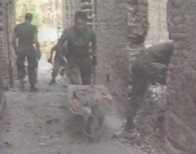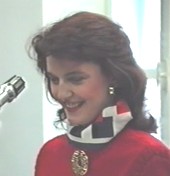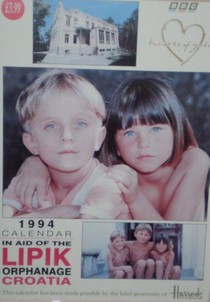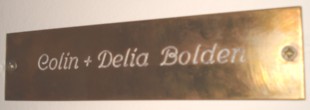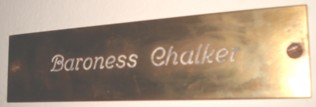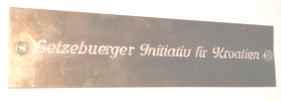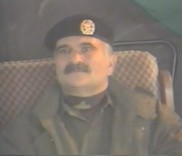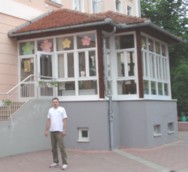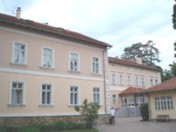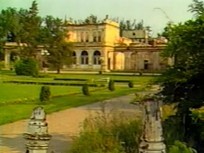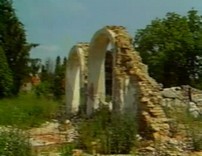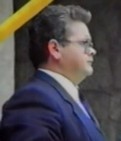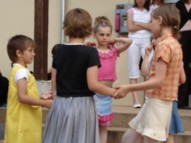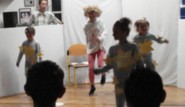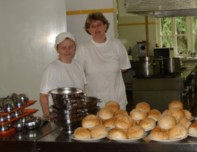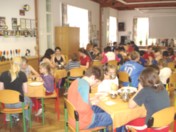The Lipik Orphanage and
Colonel Mark Cook
© by Darko Zubrinic, Zagreb (1999) [in Croatian]
Vladek Matic (Lipik Orphanage) and Valentina Murtic (Children's Home in Selce), 1993
 The Lipik Children's home was the
first object to be destroyed by Greater Serbian forces in 19 August
1991. The shelling of the city of Lipik and Pakrac started at 05.30
with the shelling of orphanage, which had 80 children, aged between 3
and 16, sleeping at the time. They took refuge in a cellar for 7 days
until they could be evacuated. The orphanage consisted of three
buildings, including kitchen and dining room, classrooms and recreation
rooms, and all were badly damaged and gutted by fire.
The Lipik Children's home was the
first object to be destroyed by Greater Serbian forces in 19 August
1991. The shelling of the city of Lipik and Pakrac started at 05.30
with the shelling of orphanage, which had 80 children, aged between 3
and 16, sleeping at the time. They took refuge in a cellar for 7 days
until they could be evacuated. The orphanage consisted of three
buildings, including kitchen and dining room, classrooms and recreation
rooms, and all were badly damaged and gutted by fire.
In October 1991 the largest Lipizzaner horse-farm in Croatia, situated near the town of Lipik, was bombed with napalm bombs.
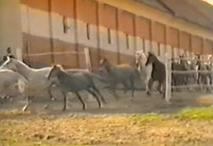
Colonel Mark Cook, the Commander of the British Contingent of the UNPROFOR in Croatia, supported by his family in Great Britain and together with British soldiers, initiated helping to rebuild the orphanage.

Mr. Mark Cook entering the ruins of Children's Home

Lipik Children's Home for Orphans destroyed by Greater Serbian forces in August 1991
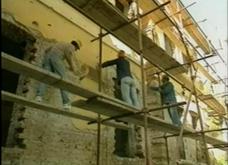
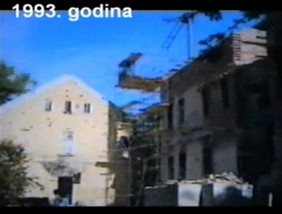
Rebuilding of Lipik Children's Home for Orphans
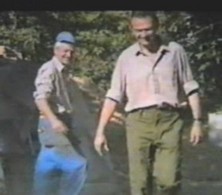
Mr. Mark Cook with Croatian workers in Lipik during rebuilding of Children's Home
By free will the British soldiers were helping to rebuild Orphans Home in Lipik at their spare time
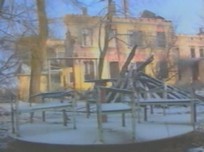
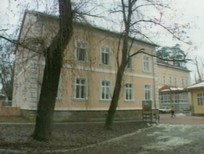
Reconstruction of the devastated Children's Home in Lipik, finished in 1993
The Lipik Orphanage (Djecji Dom) was opened in December 1993. Here we should acknowledge also very important help in the reconstruction of the city of Lipik offered by Italian government. It is interesting that Aleksandar Srzic from Makarska composed a nice march in honour of Mark Cook. About a half of expenses for renewal of the Home have been covered by the Government of the Republic of Croatia, and half by numerous donators including Croatian diaspora. The main burden of the overall organization of rebuilding the Home were taken by Mr. Mark Cook, Dr. Marica Topic and prof. Goran Nikles, director of the Lipik Orphanage.
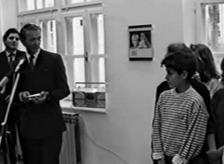
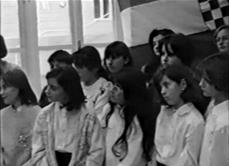
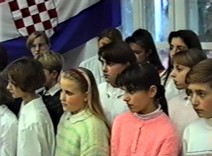
Mr. Mark Cook adressing to children at the openining of Children's Home in Lipik, 1993
Mr. Mark Cook greeting children at the main entrance of the rebuilt Lipik Orphanage, 1993
Dr. Marica Topic addressing to the participants of the opening ceremony of the Lipik Orphanage, 1993
Here are some excerpts from appeal of Colonel Mark Cook and his numerous supporters from Great Britain and other countries.
|
I made a promise to the kids to get them back into their Orphanage... You can't break promises to children. Colonel Mark Cook |
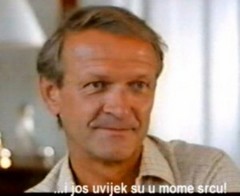
... and they are still in my heart!
The Hearts of Gold calendar has been inspired by the work of Colonel Mark Cook, a Commander of the British Section of the UN Peace Keeping Force in Croatia. He saw first hand the devastating effects of an attack on the Children's Home in Lipik which reduced the building to rubble and left the children without their only home. These orphan children come from all three communities - Serb, Croat and Bosnian Moslem, yet they have grown up together in harmony. Now the future was bleak, suddenly their home was destroyed, their hopes shattered.
The children persuaded Colonel Cook to promise to rebuild the Orphanage. The work, which will cost one million pounds, is already underway with British troops assisting local architects and tradesmen. Thanks to the Colonel the children should be able to return to their home very soon.
This calendar will raise funds to ensure the Colonel's dream is realised. We asked some of the leading photographers in the country for their favourite pictures of children. We must thank them, together with all the companies who have freely donated their time and talent to produce and print this calendar. By buying it you have helped to create a safe place for the orphaned children of Lipik. Above all we want to congratulate Colonel Cook for his dedication and the vision to rebuild their home.
Esther Rantzen & Mike Smith
BBC
hearts of gold
1994 calendar IN AID OF
THE LIPIK ORPHANAGE
CROATIA
Mr. Mark Cook and Dr. Marica Topic with children from the Lipik Orphanage
Here is a list of some of the donors, whose names are indicated on slates exhibited on walls inside the renewed building:
|
Mark Cook, Caroline Cook [wife of Mr. Mark Cook], H.R.H. Prince Hassan of Jordan, Cargilfield School, Breaside School, Sherborn Girls School, Letzebuerger Initiativ für Kroatien, Hall Grove School, Hrvatska Malteska Sluzba, Dan Eldon, Baroness Chalker, Paula Dumas - Dimmel, Mohammed El Fayed, Gerge Perinovic, Mladen Grbin, Stjepan Mandorelo, Anton Jurgens Charitable Trust, Peter Praxmarer, Suganya Lee, John Redwood, Bryan Sparrow, Sherborn Boys School, Tony Pratt, Brian Douglas, Marica Topic, Ros Hardie, Caro Brewster, Margaret Mc Lean. |

Mr. Mark Cook at the opening of Children's Orphanage in Lipik, 1993
The Lipik Orphanage in 1991 and in 1993
H.R.H. Prince Hassan of Jordan in the ruined town of Lipik
Numerous volunteers, as a rule very young, are offering their generous help in everyday work with orphans. Here are some of their impressions taken from the Guest Book of The Lipik Orphanage.
|
25. May 1999. I have had the most amazing 6 months here at Lipik and I feel so privileged to have been given the chance to know you all. Thank you for your friendship, love and patience (when I didn't understand!), and thank you for making my stay here so enjoyable. I take away many, many happy memories of the fun we had together and I will always have a special place for you in my heart. I love you all so much, and will miss you more than words can say. But I will be back to see how you are getting on, and hopefully I will be able to have a swim in the basin then! Take care of yourselves, Big Hug! Julia Abel |
Mr. Goran Nikles, director of the Home, with children at breakfast
24-25 August 1998
I was once again drawn by here by the magic quality of the home and the special people in it. I think I came to retrieve my heart which I left here 1 year ago, but once again I am forced to leave in your possession. This is where it belongs! Keep going with the work, play and laughter, they are essential parts of childhood and I'm thrilled to find so much here. I'll be back soon I'm sure, I don't know when, but I will return.
Love always,
Ursula
Testimony of prim. dr. Fuad Secerbegovic about saving Bosnian children from chetnik persecutions during WW2
It is interesting that the first railway-track from Lipik to Vienna was built in 1861 by Henry D'Heureux - Gibel, a French enterprise dealing with exploitation of oak trees. Already in 1894 the town was electrified. In 1866 Lipik had 228 inhabitants: 222 Roman Catholics, 3 Pravoslavs, and 3 Jews.
The town of Lipik is known for its very rich Recreation and Health Center, built already in the 19th century. It had
- baths with thermal mineral water, mineral water supply (300,000 liters per year),
- theatre,
- gallery
- concert and congress hall, dancing hall,
- exceptionally cultivated park area,
- olympic swimming pool,
- cultural object (Kursalon) of zero category (neo renaissance object built in 1893 according to a project of Gustav Rath, architect from Budapest),
- hotel (four stars), hospital with hydro therapeutic facilities,
- a small artificial lake with an island,
- tennis playgrounds,
- private villas in secession style, etc.
All of this was either destroyed or seriously damaged during Greater Serbian shelling and bombing (including napalm bombs) in 1991.
It is not surprising that the town of Lipik has been visited for example by such celebrities like singers Fedor I. Shalyapin and Encrico Caruso. Tino Pattiera sang in the Lipik Hospital during his treatement there, in the course of WWI.
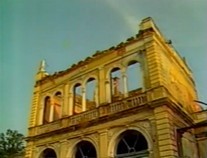
Numerous Croatian artists, above all those gathered within the association HLD SPEKTAR from Zagreb, donated altogether hundreds of their works of art to the future gallery of the town of Lipik. Many of them are exhibited in the Lipik Orphanage. Some artists from abroad also donated their works, like Janet Q. Treloar, London.
The Lipik Catholic church after the Greater Serbian destruction in 1991
Dr. Ivica Sreter, director of the Lipik Hospital,
kidnapped by Greater-Serbian forces and killed in 1991 at unknown place;
a short information about him can be found here
at Croatian Society of
Prisoners of Serbian Concentration Camps
Mr. Stjepan Horvat, mayor of the town of Lipik, donated a very nice doll dressed in a local national costume to the King of Dolls. The doll was handed over to him in Zagreb, accompanied with a special diploma. The doll and diploma are in the Ethnographic museum in Zagreb, as well as the whole collection of the King.
In 1998 Mr. Mark Cook became honorable citizen of the town of Lipik.
The following four photos represent Lipik before
1990. Many thanks to Snjezana Bozic, Zagreb, for her postcards.
 |
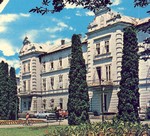 |

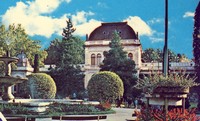
It is not widely known that very beautiful palms that adorn the riva of the city of Split in front of Diocletian's palace, have been been grown in Lipik.
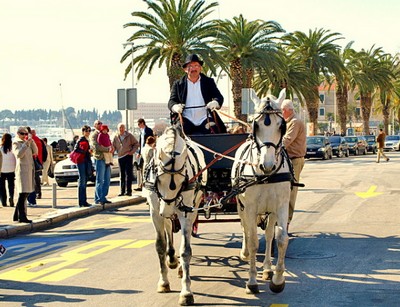
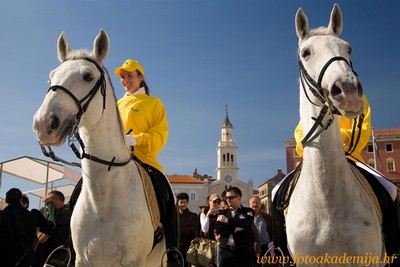
Source: www.fotoakademija.hr
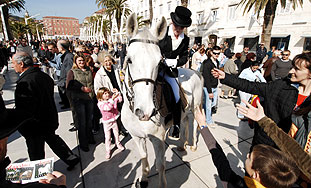
Source: thephora.net
The Lipik Lipizzaners parading on the riva of the city of Split in 2008, surrounded by beautiful plams grown - in Lipik! Croatia has the largest number of Lipizzaners in the world, about 15-16 %. In 2007 Croatia had more than a thousand Lipizzaners, out of 6000-7000 in the world. Croatia has more than 200 years of tradition of organized breeding of Lipizzaners.
Lipik 1886-1991
Lipik 1989-1991
Lipik Orphanage and Colonel Mark Cook
Hope and Homes for Children or HHC is a charity organization working in 13 countries in Eastern Europe and Africa. Their head office is based in Wiltshire in the UK. It was established by Mr. Mark Cook and his wife Caroline. The first project was an orphanage in Croatia, in Lipik. For more information see the following web pages:
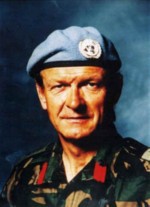
Mr. Mark Cook
Hope and Homes for Children is a charity dedicated to providing homes for children orphaned by war. Colonel Mark Cook is the former commander of the British Contingent of the U.N. Protection Force in Croatia. In 1992, in a small town Lipik (Croatia) he made a promise to the orphans that he would rebuild their home which had been completely destroyed by the Serbs. After first retiring from the armed forces, and with the support of many kind, caring people from around the world, Mark and his wife Caroline founded Hope and Homes for Children, raised over L 1 million and rebuilt a multi-ethnic home for 80 children in Lipik. (This text is taken from the web page www.streetkids.net).

I have left Croatia, but...

Clouds over the town of Lipik
Work of art by Vladimir Galina,
HLD Spektar,
at the entrance of Children's Home

One of the first photos of the Lipik Kursalon. From the family collection of Mr. Dragutin Božić, born in Lipik.
Related links:
- Povijesni prikaz djecjeg doma u Lipiku, Goran Nikles
- The Lipik Lipizzaners
- Svjedocanstvo dr. Fuada Secerbegovica
- Specijalna bolnica za medicinsku rehabilitaciju, Lipik (Lipik Hospital, directed by dr. Marica Topic)
- StreetbalLipik, basketball competition in Lipik
- Takodobra, The Lipik youth journal
- Resurrection of the town of Lipik, CROWN (D.Z.)
- The town of Lipik in past and present described on YouTube, CROWN
Literature:
- Dusko Klicek: Grad Lipik : fotomonografija : Pozdrav iz Lipika / Duško Klicek. - Lipik : Poglavarstvo grada Lipika, 2002. - 125 pp. : illustr. ; 30 cm. - ISBN 953-96542-0-3.
- Mato Curak: Mi smo htjeli - Domovinski rat 1990-1995, second edition, Bjelovar 2007, ISBN 978-953-99025-2-8
Acknowledgements. Many thanks for kind help in collecting data about the Lipik Orphanage to Stjepan Horvat (former Mayor of the town of Lipik), Antun Haramija (Mayor of Lipik), members of HLD SPEKTAR from Zagreb - in particular to Snjezana Bozic (founder of the art colony To Lipik With Love in 1997, and the founder of the Lipik Gallery), Snjezana Krejci (The Lipik Tourist Office), to Ivan Puscenik (many thanks for DVDs), and to children and staff of the Home for their hospitality.
Croatia - an overview of its History, Culture and Science



